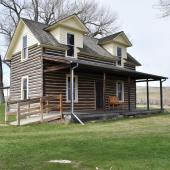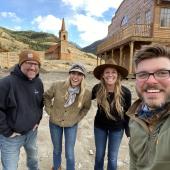The Legacy of Conservation
Here in Montana, we still enjoy a relatively low population base in a large geographic area. In fact, most reports show our state in one of the last three positions of population density in the nation. That said, some regions have been feeling the effects of growth spurts and have had to address how to manage that progression in the best manner. A noteworthy strategy that comes into play is by placing property in a “conservation easement.” One simple definition is “to protect private lands from development that would destroy or degrade a property’s scenic, wildlife, agricultural or recreational values.” While increased demands for additional housing supply pull in one direction, the need to retain our current lifestyle and wide-open space traditions is on the other side.

So why would a property owner set up a conservation easement? One reason is so that the current landowner’s vision for the land can carry forth for generations to come. Though there are many types of easements, the most common objective is to restrict future development through subdivision for residential
or commercial ventures, or to prohibit activities that affect natural resources such as mining and logging. The landowner still owns and uses their property while knowing that their heritage will live on after they do. Placing the land in a conservation easement is the only way to protect its integrity in perpetuity. As the concept of “legacy properties” becomes more prominent, this trend may continue to increase. The establishment of the easement leaves control of the property with the landowner, though allowing public access may become part of the agreement.

An important step that must be taken to ensure a conservation easement is established correctly is to meet one of the following three principles. 1) Preservation of open space. 2) Preservation of a relatively natural habitat for fish, wildlife or plants. 3) Preservation of lands for education or outdoor recreation of the general public. Once one or more of these criteria have been met, the details are negotiated with the help of land trust professionals. Conservation easements are legally binding agreements and are filed in the appropriate county courthouse. As for how long it may take to fully establish an easement, Penelope Pierce, Executive Director of the Gallatin Valley Land Trust, stated the following: “Each easement is unique. The timing from a first conversation with a landowner until the closing of the easement can range from as little as a few months up to several years depending on the complexity of the project and how quickly a landowner wants to move. We welcome the chance to visit with landowners and discuss their individual needs.”
Two other considerations come up under the “why” category of establishing a conservation easement. If the land is donated to a trust, it may qualify as a charitable contribution and have certain tax benefits for the landowner. If the land is sold to a land trust, the property is resold down the line to either a federal agency or a private buyer that will continue the conservation enhancement. Either of these options may be reason enough for a landowner to consider placing their property into a conservation easement.
The ability to correctly value a conservation easement is instrumental in the initial stages. The key is to assess how much placing the easement on the property will reduce its value if resold. The difference between the current market value and the new value with restrictions becomes the amount that can be attributed to the value of the conservation easement. Usually the addition of the easement does bring down the overall financial worth of the land. For instance, if a property was subdivided into a multitude of residential parcels, it would most likely be worth more than agricultural land as a whole. This is the rationale behind the federal tax deduction given to offset the reduced value from creating an easement. To further illustrate, an easement that does not allow homes to be built in an area with river access will have a larger value most likely than an easement which is developed to protect a specific species of wildlife. This type of valuation is completed by a professional who specializes in easement appraisals such as Clark Wheeler of Norman C. Wheeler & Associates in Bozeman.

Southwest Montana is fortunate to have a multitude of people and organizations with the common goal of preserving what makes the area so beautiful and inimitable. In order to keep any area special, it is important to retain some open space and trails. A recent success story for the Gallatin Valley Land Trust is the completion of their 100th conservation easement, which protects an additional 959 acres of land that has been farmed by a single family since 1876. The property is north of Bozeman and includes both wetlands and a wildlife wintering area. According to their website, overall GVLT has “conserved over 45,000 acres of production river bottoms, prime agricultural lands, and critical wildlife corridors throughout the Gallatin, Shields, and Paradise Valleys.” The Montana Association of Land Trusts conveys many success stories on their website of land throughout the state which has been placed in conservation easements fulfilling the goal to protect and preserve. As of this writing, MALT published that Montana land trusts and public agencies have over 1,000 conservation easements that cover over 2.1 million acres. By accessing www.montanalandtrusts.org/successes, you can read a number of examples of how private land can be conserved and/or benefit the larger population when careful planning is executed. Stories include the Sieben Live Stock Company ranch near Cascade and the Matador Ranch south of Malta, which maintains grasslands as habitat. The accounts truly make for additional quality reading.
A side topic to explore is that being conservation-minded doesn’t only have to come in the form of establishing conservation easements. A working cattle ranch near Two Dot, Montana, exemplifies an example of what conservation can mean. Jed and Annie Evjene, managers of the 26,000-acre American Fork Ranch, have made it onto the exclusive list of seven ranches nationally that are included in the Environmental Stewardship Award program. The ranch, which has been around since 1882, is a prime example of environmental stewardship, conservation and sustainability – a true champion of “conservation in action.”
While so many considerations go into the decision of whether or not a large landowner should put their property into a conservation easement, the benefits for the neighbors and future generations is substantial. Our heritage in Montana is one of good stewardship of the land and we are truly blessed in our state to have so many caring individuals that are leaving these legacies for all to come.
* * * *
Robyn Erlenbush is a third-generation Montanan who lives in Bozeman. She owns ERA Landmark Real Estate with offices in Bozeman, Big Sky, Livingston, and Ennis along with NAI Landmark Commercial, and Intermountain Property Management.












Leave a Comment Here